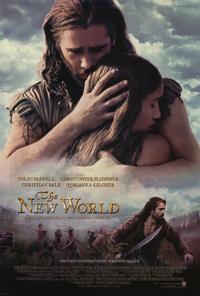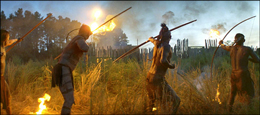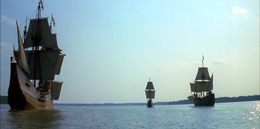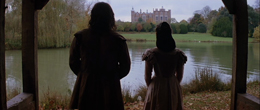Those truly interested in the transformative powers of movies relish the opportunity to see a new Terrence Malick movie on the big screen. It doesn’t come around very often. His 2011 film The Tree of Life is certainly being hailed as a cinematic masterpiece by critics, but as the awards season progresses, it’s clear that it’s too adventurous for the mainstream.
 However, his first three movies are also widely hailed as masterpieces by critics. The same cannot be said of 2006’s much-maligned The New World. Today’s Overlooked Movie Monday column exists to right this wrong. Love him or hate him, writer/director Terrence Malick has yet to make a movie that doesn’t completely envelop an audience and take control of their senses for an otherworldly experience.
However, his first three movies are also widely hailed as masterpieces by critics. The same cannot be said of 2006’s much-maligned The New World. Today’s Overlooked Movie Monday column exists to right this wrong. Love him or hate him, writer/director Terrence Malick has yet to make a movie that doesn’t completely envelop an audience and take control of their senses for an otherworldly experience.
The New World does that 100 percent, embedding the viewer in another time when life moved at a completely different pace than it does today.
Like 1978’s Days of Heaven and 1998’s The Thin Red Line, nature takes a front seat and plot-heavy histrionics are absent completely. Malick’s typically unhurried and measured pace is wholly appropriate for The New World, which expresses the awe of discovery and re-invents no less than the popular myth of our country’s founding.
The fact that the touching love story between Captain John Smith (Colin Farrell) and young native princess Pocahontas (Q’orianka Kilcher) in Jamestown, Virginia probably never took place does not take away from Malick’s ability to tap into an emotional core that few directors achieve. The movie demystifies the fabled romance, taking very seriously the implications that follow this kind of treatment. Terrence Malick also dismantles the entire rose-colored vision of America’s discovery and re-imagines historical events like the first Thanksgiving.
 The New World feels strange and new, like the English explorers must have felt coming upon a land unseen by “civilized” eyes, or how the native Algonquin people must have felt seeing those huge ships sail up to their shores.
The New World feels strange and new, like the English explorers must have felt coming upon a land unseen by “civilized” eyes, or how the native Algonquin people must have felt seeing those huge ships sail up to their shores.
Led by Captain Newport (Christopher Plummer), the settlers are full of selfish idealism, waxing philosophically about the possibilities of creating a new life and claiming the new land for themselves. The Englishmen arrive to find an unspoiled Eden, and proceed to go about spoiling it.
 Up the river, Smith’s party is attacked by the “naturals,” as the colonists call them, and end up in the hands of Powhatan (August Schellenberg). As the popular legend goes and the movie follows, Pocahontas pleads her father to spare the explorer’s life, and Smith begins to teach her English. The New World portrays Smith living among the native tribes and connecting with a new definition of himself that reflects the natives’ close relationship with nature.
Up the river, Smith’s party is attacked by the “naturals,” as the colonists call them, and end up in the hands of Powhatan (August Schellenberg). As the popular legend goes and the movie follows, Pocahontas pleads her father to spare the explorer’s life, and Smith begins to teach her English. The New World portrays Smith living among the native tribes and connecting with a new definition of himself that reflects the natives’ close relationship with nature.
While they understand and submit with modesty to the land, the English settlers force the land to submit to them. Smith considers the idea of staying with the tribe, and all its opportunities for a new way of living. It doesn’t hurt, of course, that he falls in love with the beautiful young Pocahontas. Upon his return to the camp, Smith finds madness and starvation among the men.
 Terrence Malick is not going for a huge, omniscient perspective that most epics strive to achieve, but rather the sensitive and personal point of view of the participants. They experience things like we do, with no pre-conceived sense of history in the making.
Terrence Malick is not going for a huge, omniscient perspective that most epics strive to achieve, but rather the sensitive and personal point of view of the participants. They experience things like we do, with no pre-conceived sense of history in the making.
Far from the bombastic techniques of modern historical epics, The New World is actually full of silence. By making sparing use of jump-cut editing techniques and a minimalist and repetitive score by James Horner, the events unfold with all the slow burning inevitability of real life.
 But this is not a realistic film, as such. As he does in The Tree of Life, Terrence Malick paints an impressionistic canvas as he is known to do, with shifting voice-over narration superimposed upon lyrical montages. The images themselves tell more than dialogue could, so what little speaking there is occasionally remains unintelligible.
But this is not a realistic film, as such. As he does in The Tree of Life, Terrence Malick paints an impressionistic canvas as he is known to do, with shifting voice-over narration superimposed upon lyrical montages. The images themselves tell more than dialogue could, so what little speaking there is occasionally remains unintelligible.
One of the director’s trademarks is the pretentious internal monologue, presented as if everyone’s thoughts were poetic perfection. They roam from character to character, matching the aesthetic beauty of cinematographer Emmanuel Lubezki’s shots, but sometimes becoming ponderous and, in the case of Christian Bale’s character later in the film, sometimes pushing too far.
But Malick’s vision is strong, and functions well as a parable of reconciliation. The New World that its title refers to is not only the sensual, pure land that the English discover, but also the complex and alien country that Poc ahontas encounters when she travels back to England as a guest of King James I (Jonathan Pryce). Only then, does the significance of her stature begin to sink in. She shows true maturity in the movie’s final moving scenes.
ahontas encounters when she travels back to England as a guest of King James I (Jonathan Pryce). Only then, does the significance of her stature begin to sink in. She shows true maturity in the movie’s final moving scenes.
In Malick’s film, the new world could also be a term that accurately describes what remains after mystery has disappeared. In 1607, it was the closing of a physical gap and the connecting of disparate cultures, for better or worse.
The New World should be hailed among the other Terrence Malick achievements as a unique cinematic experience that throws into focus more about being human, no matter what time period, than 99.9 percent of movies made today.








{ 4 comments }
It’s been several years since I watched this film, but all I can remember is John Smith walking through a field of grain running his fingers through the grain…this all shot from behind, and it went on forever.
To me, a great film is one that impacts you to the point that you can remember substantial story elements. I don’t just mean catch phrases like “I’m ya huckleberry” or “I’ll make him and offer he can’t refuse.” There should be something notable about the way the story connected.
Instead, the memory that stuck with me most about _The New World_ is that I wished I had rented something else.
If I had not read your thoughts just now, I would have sworn this movie was about Christopher Columbus rather than John Smith. I suppose I was vaguely remembering that Christopher Plummer was one of the actors.
At any rate, that’s how little I took away from the film.
David- I will say this about Malick’s films: You need to put yourself in the right frame of mind before watching them. You can’t expect a visceral Ridley Scott-style historical epic.
Malick extracts the bits of the myth that suit his purposes and then slows down time to make the viewer witness life as it may have unfolded back then. It certainly isn’t plot-driven and it’s not bombastic in any way. Like ‘The Tree of Life,’ it’s about a bunch of little truthful moments adding up to a bigger whole.
I’m so in love with this movie that I just recently bought the Extended Cut (more slow-moving beautiful cinematography!) and am really looking forward to it.
Well, it’s not that I require a certain pace or a significant amount of action for a film to be memorable.
_There Will Be Blood_ was slow paced, but that film stuck with me.
An even better comparison might be _Ballast_ (2008). It’s about a totally different subject and made on a considerably smaller budget than _The New World_, but it uses a “truthful moments adding up to a bigger whole” approach to storytelling. It got my attention.
So, it’s not really Malick’s method or the film’s slow pace that turns me off so much. It’s more an issue of the general effect. I honestly didn’t care any more or less for the characters in the last scene than I did in the first scene.
Yeah, I can get that. The way I got into the character was by putting myself in their shoes, especially Pocahontas. If everything in the movie was strange and new to her, it was to me as well.
Agreed on “Blood” and “Ballast,” for sure, although “Blood” has a significant amount of conflict and plot I would argue. I’m thinking after I watch the extended cut of “The New World,” I need to return to the comments section and update some thoughts…
Comments on this entry are closed.